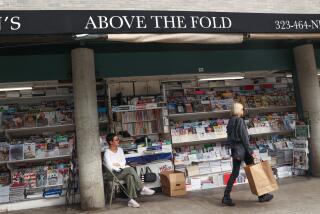Conducting an On-Site Lab in High-Tech Silicon Valley
- Share via
The San Jose Mercury News has turned its Silicon Valley home base and the entire world of new technology into a fertile field for cyberjournalism.
Knight Ridder, publisher of the San Jose paper, is the nation’s second-largest newspaper company (after Gannett), and it publicly reaffirmed its confidence in its core business in early April by buying four daily newspapers from the Walt Disney Co. for $1.65 billion. But Knight Ridder is also one of the leading print pioneers in cyberspace, and because the Mercury News is located in the Silicon Valley, it has been something of an “on-site laboratory” for its parent company, says Bob Ryan, director of the paper’s Web site, mercurycenter.com.
The Mercury News was one of the first newspapers in cyberspace, launched on American Online in May 1993 and on the World Wide Web in December 1994. The Mercury News was also one of the first online newspapers to charge for subscriptions, beginning in April 1995.
Unlike the Wall Street Journal, the Mercury News doesn’t charge for everything on its site. Users can see the headlines and first paragraphs of every story in that day’s paper without charge. But except for a free daily package of technology stories--including the popular online column “Good Morning, Silicon Valley”--readers must subscribe to see the full text of anything else in the paper. The subscription fee is $4.95 a month ($2.95 a month for subscribers to the printed paper), which is less than half what a print subscription costs.
So far, about 10,000 people have subscribed; about 40,000 people visit the site on peak days.
With “Digital High”--it’s “virtual campus” featuring material written by and for teenagers--Mercury Center hopes to add many younger users to those numbers. But the technology community--both local and global--is its primary market at present. That community is accustomed to getting its news and information by computer, and many routinely sign on to mercurycenter.com as their primary source of news.
“We update the news constantly, from 5:30 a.m. to midnight,” Ryan says, “and our Silicon Valley column is updated four times a day. When we’re late, we hear about it.”
The paper’s online edition even published a Silicon Valley potboiler, a six-month serialized novel that engendered a wide readership and prompted the creation of its own chat room where people could discuss daily plot developments online.
Like most pioneers, the Mercury News has had its share of problems--the most notable being the controversy engendered by the series of articles it published, in print and online, in August on the connections between Nicaraguan drug dealers, CIA-backed Contras and the spread of crack cocaine in South-Central Los Angeles.
As it turned out, the series was sufficiently flawed to have generated criticism even without its appearance online, but the Internet clearly gave it far greater circulation and impact than it would otherwise have had. The Washington Post, New York Times and Los Angeles Times all examined the series and concluded that it had significantly overstated its conclusions.
The online series was both promoted and accompanied by a logo that depicted a crack smoker superimposed on a CIA seal, above the words, “The story behind the crack explosion.” Many critics saw this as implying a greater CIA involvement in the “crack explosion” than the stories were able to prove. The logo was subsequently removed.
But the major problems with the series involved the original reporting and editing rather than simply its appearance on the paper’s Web site, as Jerry Ceppos, the paper’s executive editor, made clear in May, when he wrote an open letter to readers. In that letter, Ceppos acknowledged that the series “oversimplified” some material, “created impressions that were open to misinterpretation” and omitted information that “contradicted a central assertion of the series.”
“Dark Alliance” notwithstanding, the Mercury News Web site is widely regarded as one of the best on the Net.
“They’re great!” says Leah Gentry, who launched the Chicago Tribune online paper and has just been hired as the editorial director of new media at the Los Angeles Times.
More to Read
Inside the business of entertainment
The Wide Shot brings you news, analysis and insights on everything from streaming wars to production — and what it all means for the future.
You may occasionally receive promotional content from the Los Angeles Times.










